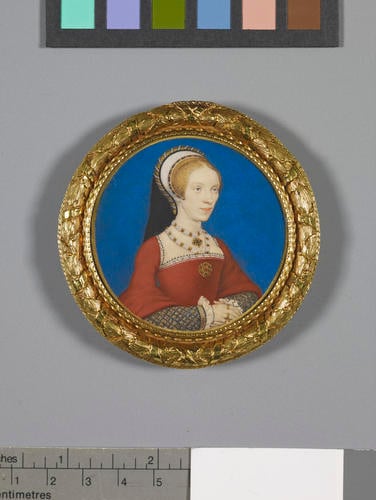-
1 of 253523 objects
Elizabeth, Lady Audley (? - 1564) c. 1538
Watercolour on vellum laid on playing card (?the ace of hearts) | 5.6 (Support diameter) (support, diameter) | RCIN 422292
-
The significance of this miniature lies in the existence of a related drawing in black and red chalks and metalpoint in the Royal Collection (RL 12191). The fact that there is no large scale surviving oil-portrait of this sitter may suggest that the drawing was intended as a preliminary study for the miniature. Such pairings can also be found in Holbein’s miniature of George Neville, Lord Abergavenny in the collection of the Duke of Buccleuch, and the related drawing in the collection of the Earl of Pembroke at Wilton House and also, arguably, in his miniature of Thomas Wriothesley, Earl of Southampton in the Metropolitan Museum of Art, New York and the related portrait drawing in the Louvre. This group of related miniatures and drawings suggests that Holbein used the same practice for his miniatures as for his large-scale portraits, making a detailed preparatory sketch from life, which he would then have used to work up the finished miniature in his studio. This technique differs significantly from that of Lucas Horenbout, Holbein’s tutor in the art of miniature painting, who is not known to have worked from drawings in this way. It also contradicts the standard practice of completing a miniature from life in three sittings of up to four hours each described by Edward Norgate in his Miniatura or the Art of Limning (c.1649).
In the present case, it accounts for the presence in the drawing of explanatory notes by Holbein over the lightly worked areas of the costume which record the texture and colour of Lady Audley’s robe and jewellery; ‘samet’ (velvet), ‘rot damast’ (red damask), ‘rot’ (red), ‘w’ (signifiying ‘weiss’ or white), ‘Gl’ (gold) and a small heart-shaped leaf signifying the colour green. This additional information might have been sufficient for Holbein to complete the miniature, although Norgate also indicates that it was common practice for ‘the apparel, Linnen, Jewells, pearls and such like’ to be taken to the artist’s studio to facilitate the completion of the later stages of the miniature. Holbein has extended the composition in the miniature and depicts Lady Audley with demurely clasped hands in a pose which is repeated in a number of other miniatures of female sitters such as his Portrait of a Lady, perhaps Catherine Howard (422293; Royal Collection), and Margaret Roper (1536, Metropolitan Museum of Art, New York) as well as in his full-scale portrait of Jane Seymour (Kunsthistorisches Museum, Vienna).
A reference in Charles II’s inventory (c.1666 – 7) draws attention to a pose of this description adopted by the sitter in a miniature: ‘A Dutch woman in a red garment holding boath her hands together In small limbning 0’2” ’. If this reference is to be associated with the present miniature, its identification as a ‘Dutch’ subject may reflect a judgment on the degree of finish and detail to be seen in the miniature at a time when contemporary miniature painting was dominated by the freedom and breadth of handling of Samuel Cooper (?1608–72) and his followers. This same miniature is then possibly traceable in the collections of James II, William III and possibly George I. However, as the first certain reference to the miniature within the Royal Collection was made in 1866, it may be that it was purchased by Queen Victoria, although no purchase matching this description has been traced in Queen Victoria’s accounts.
Identified by the later-sixteenth century inscription on the drawing as ‘Lady Audley’, the sitter is now generally accepted as Elizabeth Grey (d. 1564), daughter of the second Marquess of Dorset. The miniature may have been commissioned in celebration of her marriage, in 1538, to Thomas, Lord Audley of Walden (d. 1544), Lord Chancellor.
Text adapted from Northern Renaissance: Dürer to Holbein, London 2011Provenance
Possibly Charles II inventory, c.1666-7 (no. 405) and later in the inventories of James II, William III and George I; first recorded with certainty in the Royal Collection in 1866.
-
Creator(s)
-
Medium and techniques
Watercolour on vellum laid on playing card (?the ace of hearts)
Measurements
5.6 (Support diameter) (support, diameter)
7.6 x 7.4 cm (frame, external)
5.5 x 5.5 cm (sight diameter)
Other number(s)

